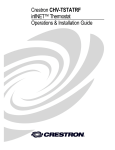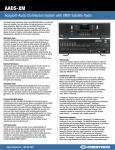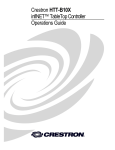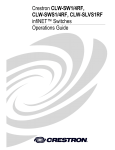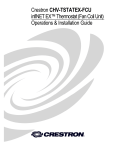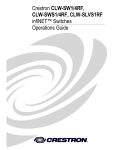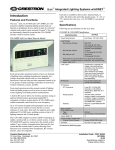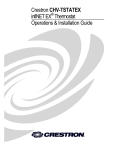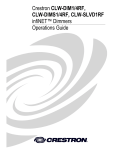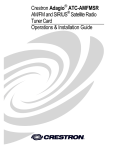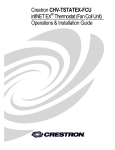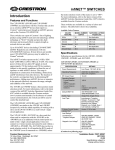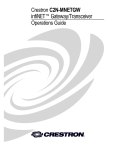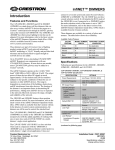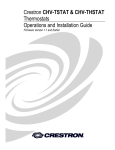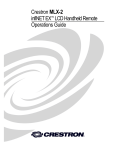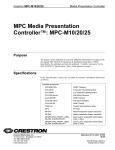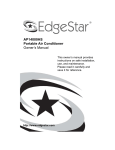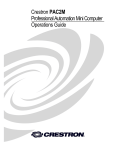Download Manual - Crestron
Transcript
Crestron CHV-TSTATRF infiNET™ Thermostat Operations & Installation Guide This document was prepared and written by the Technical Documentation department at: Crestron Electronics, Inc. 15 Volvo Drive Rockleigh, NJ 07647 1-888-CRESTRON All brand names, product names and trademarks are the property of their respective owners. ©2008 Crestron Electronics, Inc. Crestron CHV-TSTATRF infiNET™ Thermostat Contents infiNET™ Thermostat: CHV-TSTATRF 1 Introduction ............................................................................................................................... 1 Features and Functions ................................................................................................ 1 Specifications .............................................................................................................. 3 Physical Description.................................................................................................... 4 Industry Compliance ................................................................................................... 7 Installation ................................................................................................................................. 8 Mounting the CVH-TSTATRF to the Wall................................................................. 8 Wiring the CHV-TSTATRF to the HVAC System ................................................... 10 Basic Setup .............................................................................................................................. 15 Basic Thermostat Setup............................................................................................. 15 Basic infiNET™ Setup.............................................................................................. 16 Advanced Setup ....................................................................................................................... 19 Setup Mode................................................................................................................ 19 Setup Mode Parameters/Functions ............................................................................ 20 Operation ................................................................................................................................. 24 System Mode............................................................................................................. 24 Fan............................................................................................................................. 26 Setpoints .................................................................................................................... 26 Hold........................................................................................................................... 26 Remote Operation...................................................................................................... 27 LCD Display.............................................................................................................. 28 Programming Software ............................................................................................................ 30 Earliest Version Software Requirements for the PC ................................................. 30 Programming with Crestron D3 Pro or SystemBuilder ............................................. 30 Programming with SIMPL Windows ........................................................................ 30 Example Program ...................................................................................................... 32 Uploading and Upgrading........................................................................................................ 33 Establishing Communication..................................................................................... 33 Programs and Firmware ............................................................................................ 33 Program Checks ........................................................................................................ 34 Problem Solving ...................................................................................................................... 35 Troubleshooting......................................................................................................... 35 Bootloader ................................................................................................................. 36 Reference Documents................................................................................................ 37 Further Inquiries ........................................................................................................ 37 Future Updates .......................................................................................................... 37 Appendix: About Heat Pumps ................................................................................................ 38 Glossary ................................................................................................................................... 39 Return and Warranty Policies .................................................................................................. 41 Merchandise Returns / Repair Service ...................................................................... 41 CRESTRON Limited Warranty................................................................................. 41 Operations & Installation Guide – DOC. 6490A Contents • i Crestron CHV-TSTATRF infiNET™ Thermostat infiNET™ Thermostat: CHV-TSTATRF Introduction The CHV-TSTATRF is a wireless networked thermostat featuring infiNET™ wireless technology. The CHV-TSTATRF is designed to be installed easily in place of a conventional thermostat without requiring additional control wiring. Although it can be used as a standalone thermostat, the CHV-TSTATRF delivers enhanced functionality as part of a complete Crestron Home® automation system communicating via the infiNET wireless control network. The thermostat is available in three colors: the CHV-TSTATRFA in almond, the CHV-TSTATRFB in black and the CHV-TSTATRFW in white. For simplicity within this guide, these thermostats are referred to as CHV-TSTATRF. The features and specifications for all three thermostats are identical. Features and Functions • • • • • • * Wall-mounted heat/cool thermostat For baseboard, forced air and heat pump (with auxiliary heat) HVAC systems User selectable Auto mode with single or dual setpoint operation* Crestron® system integration via infiNET wireless network ⇒ 2.4 GHz infiNET mesh network technology ⇒ Range up to 150 feet indoors or 250 feet outdoors (subject to site-specific conditions) ⇒ Range may be increased with the use of additional infiNET devices or C2N-MNETRPT repeaters ⇒ “Wi-Fi” friendly operating frequencies to avoid interference Easy to read, backlit LCD display Available in white, black or almond Auto mode support requires firmware version 1.005.0005 or later. Operations & Installation Guide – DOC. 6490A infiNET™ Thermostat: CHV-TSTATRF • 1 infiNET™ Thermostat Crestron CHV-TSTATRF Heat/Cool Thermostat The CHV-TSTATRF is designed for heating and cooling control of baseboard, forced air, heat pump and dual-fuel heat pump HVAC systems. The large backlit LCD display provides a clear view of current temperature, setpoint, system mode, fan mode, system status and setup functions. Climate-control features include separate heat and cool setpoints and adjustable anticipators to prevent overshooting the desired temperature. Continuous fan operation can be selected when needed for increased circulation. infiNET™ Creston’s groundbreaking infiNET wireless technology affords reliable two-way communications throughout a home or office structure without the need for physical control wiring. Numerous infiNET thermostats and other devices can be linked to a control system via a single RF gateway. Employing a 2.4 GHz mesh network topology, every infiNET device functions as an RF repeater, increasing effective range and reinforcing the complete network by providing multiple redundant signal paths within the mesh network. In addition, a dedicated repeater (C2N-MNETRPT, sold separately) can be added to increase the system range. NOTE: The CHV-TSTATRF must be powered by 24 Volt AC source and have its power setting on “24” to allow it to function as a repeater. Automation System Integration Its wireless connection to the control system allows the functions of the CHV-TSTATRF to be controlled from touchpanels, keypads, wireless remotes and computers to support unlimited flexibility for remote control, scheduling and integration with other devices and systems. However, in the event that communication with the control system is disrupted for any reason, the CHV-TSTATRF will remain operable to control the HVAC system. Easy Installation System design, installation and upgrade using infiNET thermostats along with lighting dimmers and other devices could not be easier. Since there is no control wiring required, the CHV-TSTATRF can be installed just like any conventional thermostat. Setting up a complete network of infiNET devices is simple, utilizing dynamic discovery (self-install) to locate and acquire each RF device automatically. Setting the RF ID of each device employs the same convention as Crestron’s familiar TSID method. The RF ID can also be set manually from the local display. Each device is programmable using Crestron SIMPL™ Windows®, SystemBuilder™ or D3 Pro™ software just like any wired Cresnet® device. Even firmware updates are performed over the wireless network. No further action is required to configure the infiNET network. Each device assigned to a common gateway automatically behaves as a repeater for any other device within range (approximately 150 feet indoors) and additional repeaters may be added if necessary. At all times, the infiNET gateway monitors each device on the network, ignoring any other 2.4 GHz signals and reconfiguring the entire network automatically in response to new sources of interference and other changes in RF conditions. 2 • infiNET™ Thermostat: CHV-TSTATRF Operations & Installation Guide – DOC. 6490A Crestron CHV-TSTATRF infiNET™ Thermostat Specifications Specifications for the CHV-TSTATRF are listed in the following table. CHV-TSTATRF Specifications SPECIFICATION Wireless RF Transceiver DETAILS C2N-MNETGW gateway/transceiver required (sold separately) Two-way RF, 2.4 GHz ISM Channels 11-26 (2400 to 2483.6 MHz), IEEE 802.15.4 compliant RF Output Power 10 mW Range (typical) 150 feet indoor, 250 feet outdoor, subject to site-specific conditions; range is increased by adding additional devices or C2N-MNETRPT repeater Display Backlit LCD with two large seven-segment digits, two small seven-segment digits, 14 dedicated symbols; Displays ambient temperature, setpoint, system mode, fan setting, call activity, low battery, RF or control system communication errors, firmware download progress, setup parameter/function and value Measurement Range Ambient Temperature -10º to 110ºF (-23º to 43ºC) Display Limits -9º to 99ºF (-9º to 43ºC) Setpoint Range Heat only setpoint 38º to 89ºF (3º to 32ºC) Cool only setpoint 59º to 99ºF (15º to 37ºC) or 38º to 99ºF (3º to 37ºC) extended cool mode enabled Relay Rating 1 Amp @ 40 Volts DC or 24 Volts AC (nominal) Environmental Temperature -10º to 110ºF (-23º to 43ºC) Humidity 10% to 90% RH (non-condensing) Power Requirements Battery 0.24 Watts (10 mA @ 24 Volts AC) supplied by heating or cooling system Two AA batteries, estimated one year normal operation (with power parameter set to “Steal Power” setting) Default MNET ID 01 Minimum 2-Series Control System Update File1, 2 Version 3.154 or later Housing Injection molded plastic, surface-mountable to the front of a horizontally oriented single-gang electrical box. Dimensions Height 4.50 in (11.43 cm) Width 5.53 in (14.05 cm) Depth 1.03 in (2.60 cm) (Continued on following page) Operations & Installation Guide – DOC. 6490A infiNET™ Thermostat: CHV-TSTATRF • 3 infiNET™ Thermostat Crestron CHV-TSTATRF CHV-TSTATRF Specifications (Continued) SPECIFICATION Weight DETAILS 6.7 oz (189.9 g) Available Models CHV-TSTATRFA infiNET Thermostat, Almond CHV-TSTATRFB infiNET Thermostat, Black CHV-TSTATRFW infiNET Thermostat, White Available Accessories C2N-MNETGW infiNET Gateway/Transceiver C2N-MNETRPT infiNET Repeater 1. The latest software versions can be obtained from the Crestron website. Refer to the NOTE following these footnotes. 2. Crestron 2-Series control systems include the AV2 and PRO2. Consult the latest Crestron Product Catalog for a complete list of 2-Series control systems. NOTE: Crestron software and any files on the website are for authorized Crestron dealers and Crestron Authorized Independent Programmers (CAIP) only. New users may be required to register to obtain access to certain areas of the site (including the FTP site). Physical Description This section provides information on the connections, controls and indicators available on your CHV-TSTATRF. CHV-TSTATRF Physical View 4 • infiNET™ Thermostat: CHV-TSTATRF Operations & Installation Guide – DOC. 6490A Crestron CHV-TSTATRF infiNET™ Thermostat CHV-TSTATRF Overall Dimensions (Front and Side Views) 1.03 in (2.60 cm) 5.53 in (14.05 cm) 1 MODE 2 FAN 3 4.50 in (11.43 cm) 4 5 CHV-TSTATRF Overall Dimensions (Rear View) 3.27 in (8.30 cm) Operations & Installation Guide – DOC. 6490A infiNET™ Thermostat: CHV-TSTATRF • 5 infiNET™ Thermostat Crestron CHV-TSTATRF CHV-TSTATRF (Connection View, front with cover removed) 6 6 Connectors, Controls & Indicators # CONNECTORS, CONTROLS & INDICATORS DESCRIPTION 1 MODE BUTTON Cycles through available System Modes: OFF, HEAT, EMERGENCY HEAT (for heat pump or dual-fuel systems only), COOL and AUTO. 2 FAN BUTTON Toggles fan setting between FAN AUTO and FAN ON. Raises the setpoint. 3 (RAISE BUTTON) 4 Lowers the setpoint. (LOWER BUTTON) 5 LCD DISPLAY 6 HVAC 6 • infiNET™ Thermostat: CHV-TSTATRF Displays ambient temperature, setpoint, system mode, fan setting, call activity, low battery, RF or control system communication errors, firmware download progress, setup parameter/function and value. (4) Two-position terminal blocks. C 24 VAC common terminal supplies remote power to thermostat W Heat – Switched to RH during a call for heat in heat/cool systems or aux heat in heat pump systems O Changeover control – Switched to RC during cooling modes B Switched to RC during heating modes RH Reference Heat – Used for calls to heating system RC Reference Cool – Used for calls to cooling system G Fan – Switched to RC during call for fan Y Compressor: - Switched to RC when compressor is run Operations & Installation Guide – DOC. 6490A Crestron CHV-TSTATRF infiNET™ Thermostat Industry Compliance As of the date of manufacture the CHV-TSTATRF has been tested and found to comply with specifications for CE marking and standards per EMC and Radiocommunications Compliance Labelling. FCC ID: EROCWD1013 Compliance Statement (Part 15.19) This device complies with Part 15 of the FCC Rules. Operation is subject to the following two conditions: 1. 2. This device may not cause harmful interference and This device must accept any interference received, including interference that may cause undesired operation. Warning (Part 15.21) Changes or modifications not expressly approved by the party responsible for compliance could void the user’s authority to operate the equipment. FCC Interference Statement This equipment has been tested and found to comply with the limits for a Class B digital device pursuant to Part 15 of the FCC Rules. These limits are designed to provide reasonable protection against harmful interference in a residential installation. This equipment generates, uses and can radiate radio frequency energy and, if not installed and used in accordance with the instructions, may cause harmful interference to radio communications. However, there is no guarantee that interference will not occur in a particular installation. If this equipment does cause harmful interference to radio or television reception, which can be determined by turning the equipment off and on, the user is encouraged to try to correct the interference by one of the following measures: 1. 2. 3. 4. Reorient or relocate the receiving antenna. Increase the separation between the equipment and receiver. Connect the equipment into an outlet on a circuit different from that to which the receiver is connected. Consult the dealer or an experienced radio/TV technician for help. FCC Statement To comply with FCC’s RF exposure limits for general population / uncontrolled exposure, the antenna(s) used for this transmitter must be installed to provide a separation distance of at least 20 cm from all persons and must not be co-located or operating in conjunction with any other antenna or transmitter. Industry Canada Statement The term “IC” before the certification/registration number only signifies that the Industry Canada technical specifications were met IC: 5683A-CWD1013 Section 7.1.5 of RSS-GEN Operation is subject to the following two conditions: 1. 2. This device may not cause harmful interference, and This device must accept any interference received, including interference that may cause undesired operation. Operations & Installation Guide – DOC. 6490A infiNET™ Thermostat: CHV-TSTATRF • 7 infiNET™ Thermostat Crestron CHV-TSTATRF Installation NOTE: Installers should have a strong working knowledge of HVAC systems. Mounting the CVH-TSTATRF to the Wall The location of the thermostat can affect its performance and efficiency. Install the thermostat away from direct sunlight, drafts, doorways, skylights and windows. Also make sure the thermostat is conveniently located for control access and setup and do not mount on an exterior wall. Thermostats should be mounted 60 inches (152.4 cm) above the finished floor (HVAC industry standard). The following tools/hardware are required for installation. • Standard single-gang electrical box, mounted horizontally (not supplied) • Phillips screwdriver (not supplied) • Two 1-inch pan head Phillips screws (supplied) • Two AA batteries (supplied) Use the following procedure to install the CHV-TSTATRF in a standard, single-gang electrical box (refer to illustration on the following page): 1. Separate thermostat front plate from back plate (you may need to exert force when removing the front plate). 2. Turn HVAC system power OFF. 3. Feed HVAC wiring from the electrical box through the hole in the center of the back plate so it can be connected to the proper terminals on the CHV-TSTATRF after the thermostat is mounted. 4. Make sure unit is correctly oriented and place it in the electrical box. CAUTION: Excess wire that is pinched between the CHV-TSTATRF and electrical box could short out. Make sure that all excess wire is completely inside the electrical box and not between the box and the CHV-TSTATRF. NOTE: To ensure accurate temperature readings, avoid drafts in the back of the unit by plugging the wire hole with insulation. 5. Attach the CHV-TSTATRF back plate to the electrical box using the supplied two 1-in. pan head screws. 6. Attach faceplate. 7. Insert batteries and attach battery compartment cover. 8. Turn HVAC system power ON. NOTE: Crestron has provided small slots on either side of the battery cover, designed to allow a flathead screwdriver to be inserted to assist in removal. 8 • infiNET™ Thermostat: CHV-TSTATRF Operations & Installation Guide – DOC. 6490A Crestron CHV-TSTATRF infiNET™ Thermostat Installation view Operations & Installation Guide – DOC. 6490A infiNET™ Thermostat: CHV-TSTATRF • 9 infiNET™ Thermostat Crestron CHV-TSTATRF Wiring the CHV-TSTATRF to the HVAC System Make the necessary connections as called out in the illustrations that follow. A flat head screwdriver (not supplied) is required to attach the control wires from the HVAC system. Apply power after all connections have been made. The illustrations on the following pages show examples for connection to various types of HVAC systems. If your system does not match any of the systems described below, contact Crestron Technical Support for assistance. Connections for the CHV-TSTATRF C: 24 VAC common terminal supplies remote power to thermostat (optional) W: Heat - Switched to RH during a call for heat in heat/cool systems or aux heat in heat pump systems O: Changeover control - Switched to RC during cooling modes B: Switched to RC during heating modes Y: Compressor - Switched to RC when compressor is run G: Fan - Switched to RC during call for fan RC: Reference Cool - Used for calls to the cooling system RH: Reference Heat - Used for calls to the heating system NOTE: 24 Volt power is returned through the RH connector. Refer to wiring diagrams on the following pages. NOTE: Most heat pump systems use O for changeover. B is provided for the systems that do not. 10 • infiNET™ Thermostat: CHV-TSTATRF Operations & Installation Guide – DOC. 6490A Crestron CHV-TSTATRF infiNET™ Thermostat CHV-TSTATRF in Heat Only Application Optional, for power (Refer to “Basic Thermostat Setup” on page 15) Heat Relay System C Transformer 120 VAC R CHV-TSTATRF in Heat Only with Fan Application Optional, for power (Refer to “Basic Thermostat Setup” on page 15) Heat Relay Fan Relay System C Transformer 120 VAC R RH-RC jumper required since supply power is returned through RH NOTE: To run fan during heat calls, be sure to enable the HF parameter by setting it to “Y”. Refer to “Advanced Setup” which starts on page 19 for details. Operations & Installation Guide – DOC. 6490A infiNET™ Thermostat: CHV-TSTATRF • 11 infiNET™ Thermostat Crestron CHV-TSTATRF CHV-TSTATRF in Cool Only Application (Refer to “Basic Thermostat Setup” on page 15) C Optional, for power Y Compressor Relay G Fan Relay C Transformer R R RH-RC jumper required since supply power is returned through RH CHV-TSTATRF in Heat-Cool Application with Separate Systems Optional, for power (Refer to “Basic Thermostat Setup” on page 15) C W Heat Relay R 12 • infiNET™ Thermostat: CHV-TSTATRF R Y Compressor Relay G Fan Relay R Cooling C Transformer Heating C Transformer R Operations & Installation Guide – DOC. 6490A Crestron CHV-TSTATRF infiNET™ Thermostat CHV-TSTATRF in Heat-Cool Application with Integrated Control Unit Optional, for power C (Refer to “Basic Thermostat Setup” on page 15) W Heat Relay Y Cool Relay G Fan Relay C Transformer R R RH and RC jumpered since control unit has them on a single terminal CHV-TSTATRF in Heat Pump System Application with Integrated Controller Optional, for power (Refer to “Basic Thermostat Setup” on page 15) C RH and RC jumpered since control unit has them on a single terminal E-U-W Aux Heat Relay O Changeover Valve Y Compressor Relay G Fan Relay C Transformer R R NOTE: Heat pump and dual-fuel heat pump systems require an outdoor temperature sensor (e.g. Crestron’s C2N-RTHS, sold separately) to function properly. In SIMPL Windows, connect the “Temp” output of the sensor to the “OutdoorTemp” input of the CHV-TSTATRF. For details, refer to the SIMPL Windows help file. If using D3 Pro or SystemBuilder refer to “Programming with Crestron D3 Pro or SystemBuilder” on page 30 Operations & Installation Guide – DOC. 6490A infiNET™ Thermostat: CHV-TSTATRF • 13 infiNET™ Thermostat Crestron CHV-TSTATRF CHV-TSTATRF in Dual-Fuel Heat Pump Application Optional, for power C (Refer to “Basic Thermostat Setup” on page 15) O Changeover Valve Y Compressor Relay G Fan Relay C Transformer R R Fossil Heat System C Transformer R NOTE: The diagram above applies where furnace control is not integrated into the heat pump system. 14 • infiNET™ Thermostat: CHV-TSTATRF Operations & Installation Guide – DOC. 6490A Crestron CHV-TSTATRF infiNET™ Thermostat Basic Setup Basic Thermostat Setup The following documents the most common CHV-TSTATRF setup requirements. For full details on all setup options, refer to “Advanced Setup” which starts on page 19. Install two AA batteries (supplied) in the battery compartment. NOTE: When first setting up the CHV-TSTATRF, batteries are required, even if you plan to power it from a constant 24 VAC supply. Place the CHV-TSTATRF in the Setup mode by doing the following: 1. Press and hold the FAN button. 2. While the FAN button is being held, press and hold the simultaneously. 3. Hold all three buttons for five seconds, after which the unit will enter Setup mode. The display shows the Temperature Scale function (FC). and buttons Use or to choose the temperature units: F (Fahrenheit), C1 (setpoint in whole degrees Celsius) or C2 (setpoint in half degrees Celsius). Then press MODE twice until the Heat/Cool function is displayed (HC). Use and to choose between Heat/Cool (HC), Heat pump (HP) and Dual-fuel Heat Pump (dF) functions. Then press MODE repeatedly until the Power Source function is displayed (Po). Use and to choose between 24V always available (24) and steal power (SP). By default, the CHV-TSTATRF is configured to be powered by two AA alkaline batteries. In addition, in order to extend battery life, the device is able to steal power from the HVAC system by drawing a small amount of current through the heat or cool terminals. It will not draw enough current to cause the external heat or cool relays to close. More specifically, when the unit is not making a call for heat, it will draw power through the RH and W terminals. When the unit is making a call for heat, it will draw power through the RC and Y terminals. (This will not work if the thermostat has been wired for a cool only application.) NOTE: The CHV-TSTATRF must be wired for heat control in order to take advantage of the steal power setting. NOTE: The power stealing ability is designed to extend battery life, not to eliminate the need for batteries. Two AA batteries are still required. NOTE: When the Power Source (Po) function is set to steal power (SP), even when an auxiliary power source is available, the unit will continue to enter a communications sleep state, waking every 30 seconds or one minute (based on the infiNET Sleep Time setting) to exchange data with the control system. Refer to “Remote Operation” on page 27 for details. Operations & Installation Guide – DOC. 6490A infiNET™ Thermostat: CHV-TSTATRF • 15 infiNET™ Thermostat Crestron CHV-TSTATRF NOTE: The power stealing function may cause problems with some types of HVAC systems. While rare, the symptom would be a heat or cool call occurring when the thermostat itself does not indicate a heat or cool call. If this occurs, you should change the power setting to “24” and ensure that you have two AA batteries installed. Be aware that this situation will shorten the expected battery life. If you have wired the thermostat so that 24 Volts AC will always be present on the “C” terminal (refer to “Wiring the CHV-TSTATRF to the HVAC System” which starts on page 10), you can set the unit to run from this power supply, thus eliminating the need for batteries (except during initial setup). The thermostat will run on battery power if 24 VAC is not present. In addition, when the unit detects 24 VAC is present, it will no longer “sleep”, meaning that it will offer real-time communication with the control system. When shipped from the factory, the CHV-TSTATRF will have a steal power setting. If you plan to power the device from a constant 24 VAC supply, you must still install batteries in order to access Setup mode and change the power setting to “24”. NOTE: When the unit is powered from a constant 24 VAC supply, there may be a slight discrepancy between the ambient temperature displayed on the thermostat and the actual room temperature. This discrepancy will also be seen when switching from “SP” to “24”. This is normal and the discrepancy will disappear within approximately 10 minutes. Basic infiNET™ Setup The MNET ID of the CHV-TSTATRF has been factory set to 01. After an infiNET device is added to an infiNET network, its MNET ID must be changed to a value that can be addressed by the control system program (03 to 20). The MNET IDs of multiple CHV-TSTATRF devices on the same gateway must be unique. MNET IDs are changed locally using the setup parameter ability of the CHV-TSTATRF (refer to “Setup Mode Parameters/Functions” which starts on page 20). They can also be changed from a personal computer (PC) via the Crestron Toolbox™. When setting the MNET ID, consider the following: • The MNET ID of each unit must match an ID code specified in the SIMPL Windows or D3 Pro/SystemBuilder program. • Each network device on the same gateway must have a unique MNET ID. In Setup mode, press MODE until the infiNET ID (MNET ID) function is displayed (id). Use or to choose the infiNET ID (must be in the range from 03 to 20). Press MODE to select the infiNET RF Channel (CH). Each infiNET device communicates with its gateway on one of 16 infiNET channels. The gateway can be set to operate in an auto channel state, in which case it will operate on a single channel but may switch to a new channel if it detects excessive interference. It can also be set to operate in a fixed channel state, in which it will stay on a specified channel indefinitely. The RF channel on the thermostat must be set to correspond with the gateway with which it will be communicating. For example, if the desired gateway is running in auto channel, the thermostat must be set to auto as well. If the gateway has been set to run on a fixed channel, the thermostat should be set to that specific channel. 16 • infiNET™ Thermostat: CHV-TSTATRF Operations & Installation Guide – DOC. 6490A Crestron CHV-TSTATRF infiNET™ Thermostat Use and to choose 11 – 26 for fixed-channel operation, (Au) for auto channel or (0) to disable the radio. Disabling the radio is useful for extending battery life if, for example, you have installed the thermostat prior to installing the gateway and/or control system. Press MODE until the Start infiNET Acquire function is displayed (AC). Before an infiNET device can be used on an infiNET network, it must first be acquired by a C2N-MNETGW gateway that is connected to a Cresnet network. NOTE: An infiNET device can be acquired by only one gateway. To acquire the CHV-TSTATRF, perform the following procedure: 1. Ensure the unit is in Setup mode (refer to “Basic Thermostat Setup” on page 15 or “Setup Mode” which starts on page 19) and that Acquire mode (AC) is selected. 2. Put the C2N-MNETGW in the Acquire mode, from the unit itself by pressing ACQUIRE or from Toolbox, as described in the latest revision of the C2N-MNETGW guide (Doc. 6317), which is available for download from the Crestron website (http://www.crestron.com/manuals). The gateway ACQUIRE LED lights. NOTE: In environments where multiple gateways are installed, only one gateway should be in Acquire mode at a time. 3. Press and simultaneously on the CHV-TSTATRF to start the acquire process: display shows flashing “—” (in progress). When finished, display shows “00” (finished, found gateway) or “E#” (finished, could not find gateway), where # represents an error code. NOTE: The acquire process can take up to five minutes, depending on the RF channel. Please allow enough time for process to complete. NOTE: “E0” indicates that search time has expired and no gateway was found. “E1” indicates the RF channel is set to “0” (disabled). To enable the RF channel, refer to “infiNET RF Channel” in “Setup Mode Parameters/Functions” which starts on page 20. NOTE: To cancel an acquire process before it has completed, press the buttons simultaneously. and After the process is complete, take the C2N-MNETGW out of the Acquire mode by pressing ACQUIRE on the gateway. Refer to the latest revision of the C2N-MNETGW guide (Doc. 6317). To exit from Setup mode, press the FAN button on the CHV-TSTATRF. The Fan icon will indicate the status of infiNET communication: • Solid (non-blinking): Communication with control processor established via gateway. • Two brief blinks every eight seconds: Communication with gateway established but control system is not addressing this MNET ID. It is possible the MNET ID of the device (or the gateway ID) is not set to match the MNET ID of the D3 Pro, SystemBuilder or SIMPL Windows program. Use the Network Device Tree in Crestron Toolbox to poll the infiNET Operations & Installation Guide – DOC. 6490A infiNET™ Thermostat: CHV-TSTATRF • 17 infiNET™ Thermostat Crestron CHV-TSTATRF network. Verify that the MNET ID for the infiNET device is set to match the MNET ID specified in the program. Check the D3 Pro, SystemBuilder or SIMPL Windows program to ensure that a CHV-TSTATRF has been added at the proper MNET-ID. Refer to “Programming with Crestron D3 Pro or SystemBuilder” on page 30 or “Programming with SIMPL Windows” which starts on page 30. • Four brief blinks every eight seconds: No communication with gateway established. Refer to “Troubleshooting” which starts on page 35 for details. 18 • infiNET™ Thermostat: CHV-TSTATRF Operations & Installation Guide – DOC. 6490A Crestron CHV-TSTATRF infiNET™ Thermostat Advanced Setup Setup Mode After the CHV-TSTATRF is installed, it is necessary to set it up for a particular heating/cooling system. Please note that some of the setup parameters listed below will not always be available. Refer to “Setup Mode Parameters/Functions”, which starts on page 20 for details. Place the CHV-TSTATRF in the Setup mode by doing the following: 1. Press and hold the FAN button. 2. While the FAN button is being held, press and hold the simultaneously. 3. Hold all three buttons for five seconds, after which the unit will enter Setup mode. and buttons Once in Setup mode, the display will indicate the currently selected setup parameter/function. Press and release the MODE button quickly (must be released within one second) to change to the next parameter/function in the list. NOTE: Holding the MODE button for more than one second will reset the currently selected parameter/function to its default value. When setting parameters (such as when choosing between Fahrenheit or Celsius display), pressing the or button will increment or decrement the value. Value change occurs when button is released. When a function is selected (such as when starting an infiNET acquire), pressing either or will execute the function. To exit from Setup mode, press the FAN button on the CHV-TSTATRF. CHV-TSTATRF LCD Display (Setup Mode) Indicates current Setup Parameter/Function Indicates current value for selected Setup Parameter Skips to next Setup Parameter/Function MODE Adjust Current Setup Parameter/Function value Exits Setup Mode FAN NOTE: When the CHV-TSTATRF is in Setup mode the large seven-segment displays will show the current setup parameter/function. The small seven-segment displays will show the current value for the selected setup parameter, if applicable, or Operations & Installation Guide – DOC. 6490A infiNET™ Thermostat: CHV-TSTATRF • 19 infiNET™ Thermostat Crestron CHV-TSTATRF it will display “—” when a function is selected. All other display elements will be hidden (refer to “LCD Display” which starts on page 28). NOTE: While in Setup mode, a period of one minute with no button activity will cause the CHV-TSTATRF to revert to standard operation, unless a function (such as an infiNET acquire) is executing. Setup Mode Parameters/Functions The following table shows the available setup parameters/functions. Setup Mode Parameters/Functions PARAMETER/ FUNCTION CODE VALID VALUES DEFAULT VALUE NOTES Temperature Scale FC F, C1 or C2 F Sets units to use for temperature display (Fahrenheit or Celsius). When using Celsius temperature scale, C2 allows the setpoint to be adjusted in 0.5ºC steps. Backlight Timeout bL 1 – 4 seconds or disabled (--) -- Sets the number of seconds the backlight will remain lit after a button press. Heat/Cool Type HC Heat/Cool (HC), Heat pump (HP), Dual-Fuel Heat pump (dF) HC Sets the system type being used. Heat pump type will allow aux heat to stage with the heat pump. A dual-fuel heat pump type will not allow both systems to run at the same time. Auto mode AU Disabled (--), Dual setpoint (d) or Single setpoint (S) -- Used to enable Auto mode with single or dual setpoint operation. Auto Dead Band (will only appear when Auto mode is enabled) db 2 – 4 (for Fahrenheit) or 1 – 3 (for Celsius) 2 Used to set minimum separation between heat and cool setpoints (with dual setpoints) or maximum drift before system latches alternate mode (with single setpoint). Temperature Offset to -9 to +9 (for Fahrenheit) or -5 to +5 (for Celsius) 0 Permits recalibration of room temperature sensor. This is the number of degrees added to or subtracted from the actual temperature. This adjustment changes the actual regulation temperature, not just the display. Wide-range Cool Mode (Extended Cool) EC Enabled (Y) or Disabled (no) no Useful for wine chiller applications; extends the cool setpoint range down to the minimum used for Heat mode (38ºF/3ºC). (Continued on following page) 20 • infiNET™ Thermostat: CHV-TSTATRF Operations & Installation Guide – DOC. 6490A Crestron CHV-TSTATRF infiNET™ Thermostat Setup Mode Parameters/Functions (Continued) PARAMETER/ FUNCTION CODE VALID VALUES DEFAULT VALUE NOTES Heat Anticipator HA 1–6 3 Lower setting results in more frequent cycles and faster response (tighter regulation). Higher setting results in less frequent cycles and slower response (looser regulation). The default value should suffice in nearly all installations. Cool Anticipator CA 1–6 3 Lower setting results in more frequent cycles and faster response (tighter regulation). Higher setting results in less frequent cycles and slower response (looser regulation). The default value should suffice in nearly all installations. Heat pump Balance Point (will only appear for Heat pump and DualFuel Heat pump systems) Hb 16 to 90 (for Fahrenheit) or -9 to 32 (for Celsius) or Disabled (--) -- Heat pump systems have performance restrictions based on outdoor temperature. This setting is the minimum outdoor temperature at which the heat pump (or dual-fuel heat pump) system will run. Aux-Heat Balance Point (will only appear for Heat pump type systems) Ab 16 to 90 (for Fahrenheit) or -9 to 32 (for Celsius) or Disabled (--) -- Aux heat operation is locked out when outdoor temperature exceeds the Aux Heat Balance Point. Dual-fuel systems do not allow both the heat pump and the aux to run at the same time. Interstage Differential (will only appear for Heat pump systems) dF 05 to 80 (tenths of a degree Fahrenheit), adjustable in 5 tenths degree increments or 05 to 45 (tenths of a degree Celsius), adjustable in 5 tenths degree increments 20 (F) or 10 (C) Heat pump systems can allow both the heat pump and aux to run at the same time. This sets the ambient temperature threshold to trigger aux heat in addition to the heat pump. Run Fan During Heat Calls HF Enabled (Y) or Disabled (no) no Most heat systems handle the fan call if required. If the system requires the thermostat to control the fan during heat calls, set this parameter to “Y”. Changeover Outputs (will only appear for Heat-Cool systems) Co Enabled (Y) or Disabled (no) no Indicates the mode in which the thermostat is operating. Will automatically be engaged for heat pump or dual-fuel heat pump systems. If not required, it should be disabled to extend battery life. (Continued on following page) Operations & Installation Guide – DOC. 6490A infiNET™ Thermostat: CHV-TSTATRF • 21 infiNET™ Thermostat Crestron CHV-TSTATRF Setup Mode Parameters/Functions (Continued) PARAMETER/ FUNCTION CODE VALID VALUES DEFAULT VALUE NOTES Power Source Po 24V always available (24) or steal power (SP) 24 Selects source of input power for thermostat. 24VAC assumes constant power is available between the C and RH connectors. The steal-power function allows recovery of some power from the HVAC system when constant power is not available. Steal power may not work with some zone controllers. In this case, set value to “24” and ensure that you have two AA batteries installed. Check Firmware Version rE Firmware version is displayed in xx.yy.zz format. “—“ can also be displayed -- When firmware version is not yet shown, display will be “—“. Each press of the or button will cycle to the next portion of the version number. infiNET ID (MNET ID) id 01 and 03 – FE 01 Sets the infiNET ID. SIMPL Windows restricts infiNET devices to an ID range of 03 – 20. infiNET RF Channel CH 11-26 for fixed-channel operation, “Au” for auto or “0” for disabled (battery saver) 26 Selects the RF channel. A fixed channel allows faster setup and reconnect when the gateway channel is fixed. Auto channel allows more flexibility but may consume slightly more power if network communications are interrupted. A setting of “0” disables the radio. infiNET Sleep Time SL Short (S) or Long (L) L Indicates thermostat update rate. Setting for fewer updates (“L”) will conserve battery power. Start infiNET Acquire AC Not started (--) In progress (flashing -) Finished, found GW (00) Finished, could not find GW (E#, where # represents an error code) N/A Used to acquire the device to a gateway. ”E0” indicates that search time has expired and no gateway was found. ”E1” indicates the infiNET RF Channel is set to “0” (disabled). Unacquire Gateway UA Not started (--) In progress (flashing -) Finished, success (00) Finished, failed (E#, where # represents an error code) N/A Used to remove gateway information from the device, so it will no longer communicate with the current gateway. ”E0” indicates that there is no previous gateway information (i.e. the gateway may already have been unacquired). (Continued on following page) 22 • infiNET™ Thermostat: CHV-TSTATRF Operations & Installation Guide – DOC. 6490A Crestron CHV-TSTATRF infiNET™ Thermostat Setup Mode Parameters/Functions (Continued) PARAMETER/ FUNCTION CODE VALID VALUES DEFAUL T VALUE NOTES Check Battery Life bA Not started (--) Estimated remaining battery life (0 – 99) N/A Gives estimated remaining battery life in percent. Restore Factory Defaults Fd Not started (--) In progress (blank or flashing --) Finished (00) Button not held long enough (Er) N/A Restores all setup parameters to their default settings. To prevent accidentally performing this action, you must press and hold either the or button for three seconds for this function to execute. Perform Heat Call Test (Toggle) H Not started/Heat call off (--) Heat call on (on) (also, “H” icon will turn on) N/A Will test the heat call output. Bypasses short-cycle timers. Useful for technician system testing. Note that calling the heat may activate other relays in the thermostat as required, such as the fan output for heat pump or dual-fuel types. Perform Cool Call Test (Toggle) C Not started/Cool call off (--) Cool call on (on) (also, “C” icon will turn on) N/A Will test the cool call output. Bypasses short-cycle timers. Useful for technician system testing. Note that calling the cooling may activate other relays in the thermostat as required, such as the fan output. Perform Aux Heat Call Test (Toggle) (will appear only on Heat pump and DualFuel Heat pump systems) A Not started/Aux call off (--) Aux call on (on) (also, “A” icon will turn on) N/A Same as above, for testing aux heat output. Perform Fan Call Test (Toggle) F Not started/Fan call off (--) Fan call on (on) (also, “F” icon will turn on) N/A Same as above, for fan. Note that only the fan relay can be activated for a fan call test. Perform Self Test St Not started (--) In progress (flashing --) Finished, self test ok (00) Finished, self test failed (E#, where # represents an error code) N/A Performs a self-test of the thermostat. ”E0” indicates low battery voltage (replace batteries). ”E1” indicates low HVAC system voltage (check supply voltage – must be at least 24 VAC or 30 VDC). ”E5” indicates no gateway information (acquire the device to a C2N-MNETGW). ”E2”, “E3”, “E4”, “E6”, “E7” reserved (serious errors, contact tech support). Operations & Installation Guide – DOC. 6490A infiNET™ Thermostat: CHV-TSTATRF • 23 infiNET™ Thermostat Crestron CHV-TSTATRF Operation System Mode The MODE button on the CHV-TSTATRF will cycle the unit through all available system modes in the following order: Off, Heat, Emergency Heat (for heat pump and dual-fuel systems), Cool and Auto (if enabled in Setup). The system mode will change upon release of the MODE button and the selected mode will become operational three seconds after the mode has been entered. Off Mode In Off mode, all HVAC systems are disabled. Heat Mode In Heat mode, the thermostat uses the heating system to maintain the setpoint temperature. Emergency Heat Mode In Emergency Heat mode, the thermostat uses only the auxiliary heat output on heat pump or dual-fuel systems to maintain the setpoint temperature. NOTE: Emergency Heat mode can only be accessed when heat/cool type has been set to “Heat pump” or “Dual-Fuel Heat pump”. This setting can be useful when the heat pump is being serviced or when there is an unexpected problem with it. The display will flash the “flame” icon when the system is in Emergency Heat mode. Cool Mode In Cool mode, the thermostat uses the cooling system to maintain the setpoint temperature. Auto Mode NOTE: Auto mode support requires firmware version 1.005.0005 or later. In Auto mode, the thermostat allows the system to switch between Heat and Cool automatically as needed to maintain the setpoint temperature. By default, the CHV-TSTATRF has been configured with Auto mode disabled, meaning it is not available from the thermostat itself or via another interface such as a touchpanel. In order to enable Auto mode, you must enter Setup mode and change the “AU” setting from “--” to either “d” (dual setpoint) or “S” (single setpoint). Refer to “Setup Mode” which starts on page 19 for details. Once Auto mode has been enabled, you can access it from the CHV-TSTATRF controls as follows: 1. Press the MODE button until both the flame and snowflake appear in the display. This indicates Auto mode is now active. 24 • infiNET™ Thermostat: CHV-TSTATRF icons Operations & Installation Guide – DOC. 6490A Crestron CHV-TSTATRF infiNET™ Thermostat 2. Use the and buttons to adjust the setpoint. Actual operation will depend on whether you are using single or dual setpoints. a. In dual setpoint Auto mode, the first press of the or buttons (or second press if the first press simply turned on the backlight) will cause or snowflake icon to flash rapidly. This either the flame indicates which setpoint will be adjusted by subsequent presses of the or buttons. To adjust or view the alternate setpoint, press the MODE button while the icon is flashing. This will cause the alternate icon to flash and now the and buttons will adjust that setpoint. The flashing icon will time out after five seconds of no button activity. b. In single setpoint Auto mode, use the buttons to adjust the setpoint as usual. Dual Setpoint Auto Mode (“AU” = “d” in Setup Mode) In dual setpoint Auto mode, separate heat and cool setpoints are used. When the ambient temperature drops below the heat setpoint, the unit will call for heat to maintain the heat setpoint. When the ambient temperature rises above the heat setpoint, the unit will not call for cooling until the temperature exceeds the cool setpoint. When the ambient temperature drops below the cool setpoint, the unit will not call for heating until the temperature is below the heat setpoint. When dual setpoint Auto mode has been enabled, the Auto Dead Band is used to maintain a minimum separation between the heat and cool setpoints. If this separation is violated by a setpoint adjustment, the other setpoint will be automatically adjusted. For example, if the heat setpoint is at 68 degrees, the cool setpoint is at 72 degrees and the Auto Dead Band is set to 4 degrees, if you lower the cool setpoint to 71 degrees, the heat setpoint will automatically be adjusted to 67 degrees to maintain the 4 degree Auto Dead Band separation. In dual setpoint Auto mode, the CHV-TSTATRF display will indicate whichever setpoint is closer to the ambient temperature. Both the heat and cool setpoints can be viewed simultaneously using a touchpanel. Single Setpoint Auto Mode (“AU” = “S” in Setup Mode) In single setpoint Auto mode, a single setpoint is used for regulation at all times, regardless of whether the system is heating or cooling. The Auto Dead Band (“db”) setup parameter is used to determine when to switch between heating and cooling. For example, if the setpoint is at 70 degrees and the Auto Dead Band is set to 2 degrees, if the system is cooling, it will not start heating until the ambient temperature drops below 68 degrees (setpoint – Auto Dead Band). Once the unit has switched to heating, it will not resume cooling until the ambient temperature rises above 72 degrees (setpoint + Auto Dead Band). A larger value for the Auto Dead Band setting will result in less cycling between heating and cooling but can result in large temperature swings during the course of the day. Smaller values for the Auto Dead Band setting will result in tighter temperature regulation but more frequent cycling between heating and cooling. NOTE: When using a single setpoint, the CHV-TSTATRF has a 20-minute change limiter to prevent system toggling. Operations & Installation Guide – DOC. 6490A infiNET™ Thermostat: CHV-TSTATRF • 25 infiNET™ Thermostat Crestron CHV-TSTATRF Fan The FAN button toggles the fan setting between fan AUTO and fan ON. When set to AUTO, a fan call will be made whenever the system makes a cool call or when the system makes a heat call or auxiliary heat call (if the HF setup parameter is set to “Y”). When set to ON the fan will always run. Setpoints The setpoint is the user selectable temperature you want the system to maintain. The and buttons will change the current setpoint by one degree F or C (if Temperature Scale is set to “F” or “C1”) or by one half degree C (if Temperature Scale is set to “C2”). NOTE: While the setpoint is being adjusted, if it is set to a half-degree increment, the integer portion of the number will be displayed and will alternate with “_5” every quarter second for a period of four seconds after the last adjustment. After four seconds, only the integer portion of the number will be displayed. If the or buttons is held down for two seconds, the unit will enter an autorepeat state and the setpoint will adjust rapidly until the button is released or until the upper (or lower) limit is reached. Some users will want to have setpoints change automatically based on the day of the week and the time of day. For example, in the winter they may want to lower the heat setpoint while they sleep to lower heating costs. To accommodate this, the CHV-TSTATRF provides a “Scheduled Heat Setpoint” and a “Scheduled Cool Setpoint” which can be specified by the control system program. This is handled automatically by the “Crestron CHV-TSTATRF w/5-2 Scheduler” module provided with the Crestron Database. Refer to “Programming with SIMPL Windows” which starts on page 30 for more details about how to add this module to your program. For dual setpoint operation, refer to “Auto Mode” which starts on page 24. Hold Hold allows the user to adjust the setpoint and will maintain that setpoint until the unit is taken out of Hold. This means that any change to the scheduled heat or cool setpoint that occurs while in Hold will be ignored until the unit is taken out of Hold. Pressing the MODE and FAN buttons simultaneously will cause the unit to enter Hold if Hold is not yet active and the system mode is Heat, Emergency Heat or Cool. Pressing the MODE and FAN buttons simultaneously when Hold is active will cause the unit to exit from Hold and recall either the scheduled heat setpoint or scheduled cool setpoint as appropriate to the system mode. If the system is in single setpoint Auto mode, exiting from Hold will recall the scheduled auto setpoint. If the system is in dual setpoint Auto mode, upon exiting from Hold, the auto cool setpoint becomes the scheduled cool setpoint and the auto heat setpoint becomes the scheduled heat setpoint. Pressing the MODE and FAN buttons simultaneously when the system mode is Off will have no effect. When Hold is active, the unit will continue to adjust the current setpoint when the or buttons are pressed. The unit will also continue to adjust the current setpoint when the setpoint signal from the control system changes. 26 • infiNET™ Thermostat: CHV-TSTATRF Operations & Installation Guide – DOC. 6490A Crestron CHV-TSTATRF infiNET™ Thermostat When the system mode changes to Heat or Emergency Heat, the current setpoint will be set to the scheduled heat setpoint. When the system mode changes to Cool, the current setpoint will be set to the scheduled cool setpoint. Remote Operation As an infiNET device, the CHV-TSTATRF can be controlled remotely via a Crestron control system. Most often, control of the thermostat will be achieved via a touchpanel or web-based graphical interface. In order to extend battery life, the thermostat will only communicate with the control system once every 30 seconds or one minute, based on the infiNET Sleep Time setting. Because of this, there will be a noticeable delay between the time a button is pressed on a touchpanel and when the thermostat reacts to the command. To account for this, the CHV-TSTATRF modules written by Crestron and provided in the Crestron Database will mimic the feedback from the thermostat so that the user will see an immediate response on the touchpanel. Likewise, pressing a local button on the thermostat (for example, setpoint raise or lower) will not cause an immediate change to the corresponding display on a touchpanel. Instead, the thermostat will wake up approximately 10 seconds after the last button press to send its updated status to the control system. NOTE: When the CHV-TSTATRF is powered via a constant 24 VAC supply, it will not go to sleep. Operations & Installation Guide – DOC. 6490A infiNET™ Thermostat: CHV-TSTATRF • 27 infiNET™ Thermostat Crestron CHV-TSTATRF LCD Display CHV-TSTATRF LCD Display 1 2 F C HOLD H C F A 8 9 OFF AUTO 3 4 5 6 7 LCD Display Elements # LCD DISPLAY ELEMENT DESCRIPTION 1 Large seven-segment digits Indicates current ambient temperature1, 2. In Setup mode, indicates current setup parameter/function. Display range is limited to –9º to 99ºF (-9º to 43ºC). If the ambient temperature is above 99º, the display will indicate 99º. If the ambient temperature is below –9º, the display will indicate –9º. 2 Small seven-segment digits Indicates current setpoint (in F or C) in whole degrees. While the setpoint is being adjusted, if it is set to a half-degree increment, the integer portion of the number will be displayed and will alternate with “_5” every quarter second for a period of four seconds after the last adjustment. After four seconds, only the integer portion of the number will be displayed. In Setup mode, indicates current value for selected Setup Parameter. 3 Flame icon Displayed when the system mode is Heat. Flashes (on two seconds, off one half second) when the system mode is Emergency Heat. Displayed with snowflake icon when system is in Auto mode. 4 Snowflake icon Displayed when the system mode is Cool. Displayed with flame icon when system is in Auto mode. (Continued on following page) 28 • infiNET™ Thermostat: CHV-TSTATRF Operations & Installation Guide – DOC. 6490A Crestron CHV-TSTATRF infiNET™ Thermostat LCD Display Elements (Continued) # LCD DISPLAY ELEMENT 5 Fan icon 6 AUTO indicator 7 OFF indicator 8 HOLD indicator 9 H, C, F & A indicators DESCRIPTION Displayed at all times. Flashes if a communication error occurs. Displayed when FAN setting is AUTO. If this is not displayed, FAN is always ON. Displayed when the system mode is Off. Displayed when the HOLD setting is active. H – Displayed whenever a Heat Call is being made. C – Displayed whenever a Cool Call is being made. F – Displayed whenever a Fan Call is being made. A – Displayed whenever an Aux Heat Call is being made. 1. For heat pump and dual-fuel systems, when you select Emergency Heat mode (by pressing and releasing the MODE button when System mode is Heat) the display will show “EH” in place of the ambient temperature for two seconds. 2. When the CHV-TSTATRF detects a low battery condition (approximately one month of battery life remaining), the display will alternate “Lo” in place of the ambient temperature once per second. Operations & Installation Guide – DOC. 6490A infiNET™ Thermostat: CHV-TSTATRF • 29 infiNET™ Thermostat Crestron CHV-TSTATRF Programming Software Have a question or comment about Crestron software? Answers to frequently asked questions (FAQs) can be viewed in the Online Help section of the Crestron website. To post a question or view questions you have submitted to Crestron’s True Blue Support, log in at http://support.crestron.com. First-time users will need to establish a user account. Earliest Version Software Requirements for the PC NOTE: Crestron recommends that you use the latest software to take advantage of the most recently released features. The latest software is available from the Crestron website. Crestron has developed an assortment of Windows-based software tools to develop an infiNET system. For the minimum recommended software versions, visit the Version Tracker page of the Crestron website (www.crestron.com/versiontracker). Programming with Crestron D3 Pro or SystemBuilder Crestron D3 Pro or SystemBuilder is the easiest method of programming but does not offer as much flexibility as SIMPL Windows. For additional details, download D3 Pro or SystemBuilder from the Crestron website and examine the extensive help files. NOTE: Heat pump and dual-fuel heat pump systems require an outdoor temperature sensor (e.g. Crestron’s C2N-RTHS, sold separately) to function properly. Use a “Connect” step to attach the sensor’s “Temp” output to the “OutdoorTemp” input of the CHV-TSTATRF. Programming with SIMPL Windows NOTE: While SIMPL Windows can be used to program the CHV-TSTATRF, it is recommended to use SystemBuilder or D3 Pro for configuring a system. SIMPL Windows is Crestron’s premier software for programming Crestron control systems. It is organized into two separate but equally important “Managers”. Configuration Manager Configuration Manager is the view where programmers “build” a Crestron control system by selecting hardware from the Device Library. • To incorporate the CHV-TSTATRF into the system, first drag the C2N-MNETGW (MNET Gateway) from the Wireless Receivers | Wireless Receivers (RF) folder of the Device Library and drop it in the System Views. Then drag the module from the infiNET Control Modules | infiNET Sensing Modules folder of the Device Library and drop it on the C2N-MNETGW. 30 • infiNET™ Thermostat: CHV-TSTATRF Operations & Installation Guide – DOC. 6490A Crestron CHV-TSTATRF infiNET™ Thermostat NOTE: It is not recommended to add the CHV-TSTATRF directly. Instead, add one of the available “modules” listed underneath it as shown below. Locating the C2N-MNETGW in the Device Library Locating the CHV-TSTATRF in the Device Library • The system tree of the control system displays the device in the appropriate slot with a default MNET ID as shown in the following illustration. C2Net Device, Slot 9 • Additional CHV-TSTATRF devices are assigned different MNET ID numbers as they are added. • If necessary, double click a device to open the “Device Settings” window and change the MNET ID, as shown in the following figure. Operations & Installation Guide – DOC. 6490A infiNET™ Thermostat: CHV-TSTATRF • 31 infiNET™ Thermostat Crestron CHV-TSTATRF “CHV-TSTATRF Device Settings” Window • Program Manager The ID code specified in the SIMPL Windows program must match the MNET ID of each unit. Program Manager is the view where programmers “program” a Crestron control system by assigning signals to symbols. The symbol can be viewed by double clicking on the icon or dragging it into Detail View. Each signal in the symbol is described in the SIMPL Windows help file (F1). Example Program An example program for the CHV-TSTATRF is available from the Crestron website (http://www.crestron.com/exampleprograms). 32 • infiNET™ Thermostat: CHV-TSTATRF Operations & Installation Guide – DOC. 6490A Crestron CHV-TSTATRF infiNET™ Thermostat Uploading and Upgrading Crestron recommends using the latest programming software and that each device contains the latest firmware to take advantage of the most recently released features. However, before attempting to upload or upgrade it is necessary to establish communication. Once communication has been established, files (for example, programs or firmware) can be transferred to the control system (and/or device). Finally, program checks can be performed (such as changing the device ID) to ensure proper functioning. Establishing Communication Use Crestron Toolbox for communicating with the CHV-TSTATRF; refer to the Crestron Toolbox help file for details. There is a single method of communication: indirect serial communication. Indirect Serial Communication C2N-MNETGW infiNET CHV-TSTATRF SERIAL, ETHERNET OR USB PC RUNNING CRESTRON TOOLBOX CRESNET CONTROL SYSTEM • CHV-TSTATRF connects to the C2N-MNETGW (Gateway), which connects to the control system via Cresnet. • Establish communications between the PC and the control system as described in the latest version of the 2-Series Control Systems Reference Guide (Doc. 6256). Programs and Firmware Program or firmware files may be distributed from programmers to installers or from Crestron to dealers. Firmware upgrades are available from the Crestron website as new features are developed after product releases. One has the option to upload programs via the programming software or to upload and upgrade via the Crestron Toolbox. For details on uploading and upgrading, refer to the SIMPL Windows help file or the Crestron Toolbox help file. SIMPL Windows If a SIMPL Windows program is provided, it can be uploaded to the control system using SIMPL Windows or Crestron Toolbox. Operations & Installation Guide – DOC. 6490A infiNET™ Thermostat: CHV-TSTATRF • 33 infiNET™ Thermostat Firmware Crestron CHV-TSTATRF Check the Crestron website to find the latest firmware. (New users may be required to register to obtain access to certain areas of the site, including the FTP site.) Upgrade CHV-TSTATRF firmware via Crestron Toolbox. • Establish communications with the CHV-TSTATRF and display the “System Info” window. • Select Functions | Firmware… to upgrade the CHV-TSTATRF firmware. Since the CHV-TSTATRF might be “asleep”, there may be a delay of one minute or less before the update starts. Program Checks Using Crestron Toolbox, display the network device tree (Tools | Network Device Tree) to show all network devices connected to the control system and all infiNET devices that have been acquired by the CHV-TSTATRF (C2N-MNETGW). Rightclick on the CHV-TSTATRF (C2N-MNETGW) to display actions that can be performed on the CHV-TSTATRF (C2N-MNETGW). 34 • infiNET™ Thermostat: CHV-TSTATRF Operations & Installation Guide – DOC. 6490A Crestron CHV-TSTATRF infiNET™ Thermostat Problem Solving Troubleshooting The following table provides corrective action for possible trouble situations. If further assistance is required, please contact a Crestron customer service representative. CHV-TSTATRF Troubleshooting TROUBLE No display Device does not follow control system commands. Heating/Cooling system is not operating. POSSIBLE CAUSE(S) CORRECTIVE ACTION No power from system. Check for +24V on C connector. Check circuit breaker powering furnace or boiler. Check thermostat wiring. Check batteries (if running on battery power). Incorrect mounting to back plate. Check thermostat mounting. Device is not communicating with the C2N-MNETGW. Open Crestron Toolbox and select the Network Device Tree. Expand the tree until the gateway to be managed is selected. Right-click the NET ID of the selected gateway to open the sub-menu and select Functions | MNET Gateway… If device is not listed, acquire the device to the infiNET network (refer to ”Basic Thermostat Setup” which starts on page 15). MNET ID of device (or the gateway ID) is not set to match the MNET ID of the SIMPL Windows program. Use the Network Device Tree infiNET network in Crestron Toolbox to poll the infiNET network. Verify that the MNET ID for the infiNET device is set to match the MNET ID specified in the SIMPL Windows program. Device has entered a state of “hibernation”. If the thermostat is unable to locate its gateway for a period of one hour, in order to prevent excess battery usage, it will hibernate. In this state, it will only look for the gateway once every 20 minutes. To remedy this, press any button on the thermostat. It should look for the gateway within 10 seconds. No power to thermostat. Check circuit breaker. Check for +24V on C connector. Check circuit breaker powering furnace or boiler. Recheck wiring connections. Check batteries, replace if necessary. (Continued on following page) Operations & Installation Guide – DOC. 6490A infiNET™ Thermostat: CHV-TSTATRF • 35 infiNET™ Thermostat Crestron CHV-TSTATRF CHV-TSTATRF Troubleshooting (Continued) TROUBLE POSSIBLE CAUSE(S) CORRECTIVE ACTION Cannot change setpoint setting. The upper or lower temperature limits were reached. Heat setpoint range is 38º to 89ºF (3º to 32ºC). Cool setpoint range is 59º to 99ºF (15º to 37ºC) or 38º to 99ºF (3º to 37ºC) if extended cool mode enabled. System cycles too quickly. Anticipator setting is too low. Reprogram anticipator setting (refer to “Setup Mode Parameters/Functions” which starts on page 20). Room has high temperature variance. Anticipator setting is too high. Reprogram anticipator setting (refer to “Setup Mode Parameters/Functions” which starts on page 20). Wide temperature variance in single setpoint Auto mode. Auto dead band setting is too high. Reprogram auto dead band (db) setting (refer to “Setup Mode Parameters/Functions” which starts on page 20). Heating/Cooling not operating in single setpoint Auto mode. 20-minute system toggling lockout. Reprogram auto dead band (db) and anticipator settings for smoother operation (refer to “Setup Mode Parameters/Functions” which starts on page 20). Wrong temperature is displayed. Wrong temperature scale. Select F or C as necessary. A Temperature Offset has been applied. Reset Temperature Offset (refer to “Setup Mode Parameters/Functions” which starts on page 20). Bad location. Ensure the thermostat is located away from direct sunlight, drafts, doorways, skylights and windows or exterior walls. Steal power function may be causing problems with HVAC system. Change power setting (Po) to “24” and ensure you have two AA batteries installed. Improper wiring connections. Recheck wiring connections. Auto mode is disabled in setup. Reprogram Auto mode setting (AU) to “S” (for single setpoint operation) or “d” (for dual setpoint operation) (refer to “Setup Mode Parameters/Functions” which starts on page 20). Heat or cool call occurs but device does not indicate a heat or cool call. Can not enter Auto mode. Bootloader The bootloader is a low-level version of the CHV-TSTATRF’s firmware that will become active in the event an upload of the standard firmware fails. This lets you perform some basic functions with the goal of getting the CHV-TSTATRF back to normal operation. 36 • infiNET™ Thermostat: CHV-TSTATRF Operations & Installation Guide – DOC. 6490A Crestron CHV-TSTATRF infiNET™ Thermostat If the CHV-TSTATRF goes into bootloader, the large seven-segment display will show “Ld”, except when in Setup mode. All other LCD segments will be off. All button presses will be ignored, except for the sequence which enters Setup mode (refer to “Setup Mode” which starts on page 19). From the bootloader, Setup mode will support only the following functions: • Check Firmware Version (rE) • infiNET ID (id) • infiNET RF Channel (CH) • Start infiNET Acquire (AC) • Unacquire Gateway (UA) To restore functionality, try cycling power to the CHV-TSTATRF. If unit remains in bootloader, you should resend the latest firmware using Crestron Toolbox. NOTE: To manually enter bootloader, press and hold the MODE button for 10 seconds during unit power up. Reference Documents The latest version of all documents mentioned within the guide can be obtained from the Crestron website (http://www.crestron.com/manuals). This link will provide a list of product manuals arranged in alphabetical order by model number. List of Related Reference Documents DOCUMENT TITLE 2-Series Control Systems Reference Guide C2N-MNETGW infiNET Gateway/Transceiver Further Inquiries If you cannot locate specific information or have questions after reviewing this guide, please take advantage of Crestron's award winning customer service team by calling Crestron at 1-888-CRESTRON [1-888-273-7876]. You can also log onto the online help section of the Crestron website (www.crestron.com/onlinehelp) to ask questions about Crestron products. First-time users will need to establish a user account to fully benefit from all available features. Future Updates As Crestron improves functions, adds new features and extends the capabilities of the CHV-TSTATRF, additional information may be made available as manual updates. These updates are solely electronic and serve as intermediary supplements prior to the release of a complete technical documentation revision. Check the Crestron website periodically for manual update availability and its relevance. Updates are identified as an “Addendum” in the Download column. Operations & Installation Guide – DOC. 6490A infiNET™ Thermostat: CHV-TSTATRF • 37 infiNET™ Thermostat Crestron CHV-TSTATRF Appendix: About Heat Pumps A heat pump extracts available heat from one area and transfers it to another. Even cold air contains some heat and heat pumps can extract heat from the outside air on a cold day and transfer it indoors to maintain a comfortable temperature. A heat pump also works in reverse during the summer, extracting heat from indoors and transferring it outdoors. In the heating mode, the efficiency of a heat pump decreases as the outdoor air temperature decreases. Heat Pump Operation Heat flows naturally from a warm area to a cooler area and the heat pump takes advantage of this principle. The heat pump essentially consists of a compressor, an inside coil and fan and an outside coil and fan. A refrigerant flows inside the coils, under pressure applied by the compressor. The refrigerant boils at a very low temperature (as low as -15° F) and becomes a vapor, just as water becomes a vapor (steam) when boiled. This vapor is sucked into the compressor where it becomes a high pressure, high temperature vapor. When heating, the refrigerant is then forced through a coil within part of the heat pump located indoors. A fan blows cool air over the coil, the vapor cools, turns back to a liquid, releasing heat that is blown through a duct system to heat the house. The cycle begins again as the cooled liquid refrigerant is pumped back outside after releasing it’s heat. On the way, it passes through an expansion valve, lowering the refrigerant's pressure and temperature again so it can boil more easily in the outdoor coil. In its cooling mode the heat pump system works in reverse, extracting available heat from indoors and transferring it outside. Heat pumps are most economical when they can be used year-round for both winter heating and summer cooling. The efficiency of a heat pump varies significantly with the outdoor temperature. While a heat pump may be twice as efficient as a conventional heating system at 50°F. When the outdoor temperature drops to less than 30°F, the heat pump must be supplemented with an auxiliary heating system such as electric resistance. At temperatures of 15°F or less the heat pump may shut off and the backup heating system takes over. This is the heat pump balance point. In a dual-fuel system, the heat pump is supplemented with a standard furnace, which takes over when it becomes more efficient than the heat pump at very low temperatures. The heat pump type setting (HP) of the Heat/Cool Type (HC) setup parameter will allow aux heat to stage with the heat pump. A dual-fuel type setting (dF) will not allow both systems to run at the same time. 38 • infiNET™ Thermostat: CHV-TSTATRF Operations & Installation Guide – DOC. 6490A Crestron CHV-TSTATRF infiNET™ Thermostat Glossary Anticipators Used to anticipate the drop or rise in temperature and energize the appropriate system before reaching the set point. Anticipators affect how tightly the setpoint temperature is maintained. Auto Dead Band Sets the minimum separation in auto mode between heat and cool setpoints (with dual setpoints) or maximum drift before system latches alternate mode (with single setpoint). Balance Point At low outdoor temperatures, the refrigeration cycle of a heat pump will not be able to supply the heating requirements without the aid of a supplementary heat source. At higher outdoor temperatures, it is inefficient to use supplementary heat. The heat pump balance point sets the minimum outdoor temperature required to allow operation of the heat pump. Additionally, for conventional heat pump system types (Heat/Cool Type setup parameter = HP), the AuxHeat Balance Point sets the maximum outdoor temperature to allow operation of the auxiliary heat. Since dual fuel system types only allow operation of one system at a time, only one balance point is available. Blower (Fan) An air-handling device for moving air in a distribution system. Call A call is the action taken by the thermostat when it sends a signal to turn on the heating or cooling system. Dual Fuel A heat pump used in conjunction with an existing fossil fueled furnace. Emergency Heat (Supplementary Electric Heat) The auxiliary (AUX) or emergency heat provided at temperatures below a heat pump's balance point. It is usually electrical resistance heat. Extended Cool Extends the cool setpoint range to the full auto range of 38 to 99°F. Forced Air A type of heating system that uses a blower motor to move air through the furnace and into the ductwork. Furnace Equipment used to convert heating energy, such as fuel, oil, gas or electricity, to usable heat. It usually contains a heat exchanger, a blower and the controls to operate the system. Heat Pump A unit that both cools and heats. A heat pump system can be either a split system or a packaged system. A heat pump can be used in conjunction with a gas/oil/LP furnace (using the furnace instead of electric resistance heat when temperatures fall below about 35º F). Operations & Installation Guide – DOC. 6490A infiNET™ Thermostat: CHV-TSTATRF • 39 infiNET™ Thermostat Crestron CHV-TSTATRF Humidity The total amount of moisture in air. Relative humidity (RH) is the amount of moisture in air, relative to its total capability based upon its temperature (dew point). Moisture will condense on surfaces that are below this dew point. HVAC Heating, ventilation and air conditioning. Interstage Differential The proportional temperature error (0.5 to 3.0º) to trigger the second stage (2-stage only), such as the aux heat for a heat pump type system. Run Fan in Heat Calls A device setting that activates the fan output during heat (W) calls. (For heat pump or dual fuel system types, this setting activates the fan during calls for auxiliary heat. Setpoint The user selectable temperature you want the system to maintain. Time Delay (Timer Guards) Refers to a safety device or circuit that will not allow restart for three minutes. 40 • infiNET™ Thermostat: CHV-TSTATRF Operations & Installation Guide – DOC. 6490A Crestron CHV-TSTATRF infiNET™ Thermostat Return and Warranty Policies Merchandise Returns / Repair Service 1. No merchandise may be returned for credit, exchange or service without prior authorization from CRESTRON. To obtain warranty service for CRESTRON products, contact an authorized CRESTRON dealer. Only authorized CRESTRON dealers may contact the factory and request an RMA (Return Merchandise Authorization) number. Enclose a note specifying the nature of the problem, name and phone number of contact person, RMA number and return address. 2. Products may be returned for credit, exchange or service with a CRESTRON Return Merchandise Authorization (RMA) number. Authorized returns must be shipped freight prepaid to CRESTRON, 6 Volvo Drive, Rockleigh, N.J. or its authorized subsidiaries, with RMA number clearly marked on the outside of all cartons. Shipments arriving freight collect or without an RMA number shall be subject to refusal. CRESTRON reserves the right in its sole and absolute discretion to charge a 15% restocking fee plus shipping costs on any products returned with an RMA. 3. Return freight charges following repair of items under warranty shall be paid by CRESTRON, shipping by standard ground carrier. In the event repairs are found to be non-warranty, return freight costs shall be paid by the purchaser. CRESTRON Limited Warranty CRESTRON ELECTRONICS, Inc. warrants its products to be free from manufacturing defects in materials and workmanship under normal use for a period of three (3) years from the date of purchase from CRESTRON, with the following exceptions: disk drives and any other moving or rotating mechanical parts, pan/tilt heads and power supplies are covered for a period of one (1) year; touchscreen display and overlay components are covered for 90 days; batteries and incandescent lamps are not covered. This warranty extends to products purchased directly from CRESTRON or an authorized CRESTRON dealer. Purchasers should inquire of the dealer regarding the nature and extent of the dealer's warranty, if any. CRESTRON shall not be liable to honor the terms of this warranty if the product has been used in any application other than that for which it was intended or if it has been subjected to misuse, accidental damage, modification or improper installation procedures. Furthermore, this warranty does not cover any product that has had the serial number altered, defaced or removed. This warranty shall be the sole and exclusive remedy to the original purchaser. In no event shall CRESTRON be liable for incidental or consequential damages of any kind (property or economic damages inclusive) arising from the sale or use of this equipment. CRESTRON is not liable for any claim made by a third party or made by the purchaser for a third party. CRESTRON shall, at its option, repair or replace any product found defective, without charge for parts or labor. Repaired or replaced equipment and parts supplied under this warranty shall be covered only by the unexpired portion of the warranty. Except as expressly set forth in this warranty, CRESTRON makes no other warranties, expressed or implied, nor authorizes any other party to offer any warranty, including any implied warranties of merchantability or fitness for a particular purpose. Any implied warranties that may be imposed by law are limited to the terms of this limited warranty. This warranty statement supersedes all previous warranties. Trademark Information All brand names, product names and trademarks are the sole property of their respective owners. Windows is a registered trademark of Microsoft Corporation. Windows95/98/Me/XP/Vista and WindowsNT/2000 are trademarks of Microsoft Corporation. Operations & Installation Guide – DOC. 6490A infiNET™ Thermostat: CHV-TSTATRF • 41 infiNET™ Thermostat Crestron CHV-TSTATRF This page is intentionally left blank. 42 • infiNET™ Thermostat: CHV-TSTATRF Operations & Installation Guide – DOC. 6490A Crestron CHV-TSTATRF infiNET™ Thermostat This page is intentionally left blank. Operations & Installation Guide – DOC. 6490A infiNET™ Thermostat: CHV-TSTATRF • 43 Crestron Electronics, Inc. 15 Volvo Drive Rockleigh, NJ 07647 Tel: 888.CRESTRON Fax: 201.767.7576 www.crestron.com Operations & Installation Guide – DOC. 6490A (2015101) 11.08 Specifications subject to change without notice.
















































